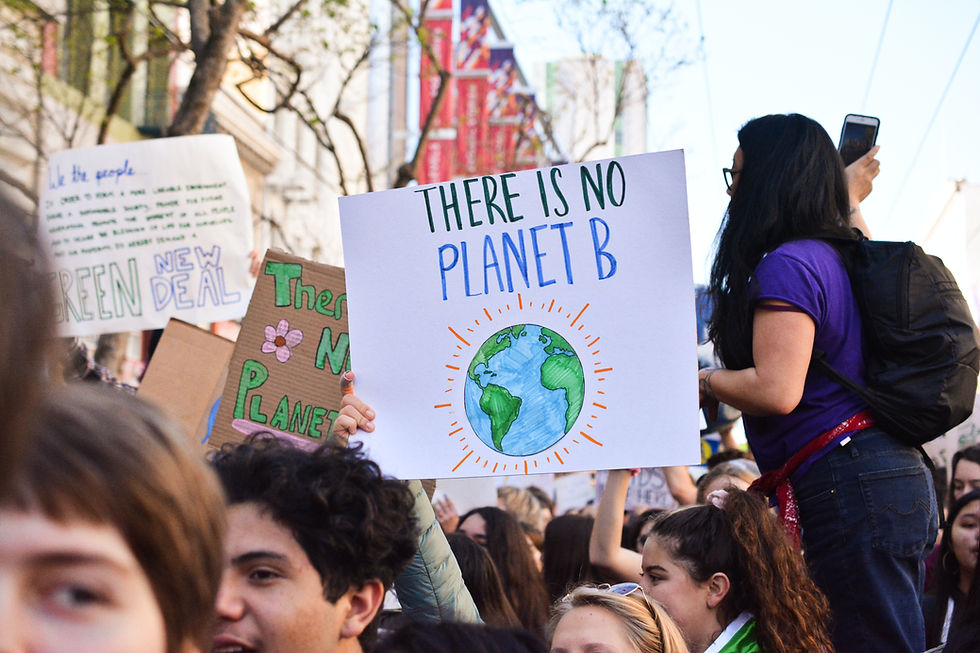How Fast Fashion is Destroying Our Planet
- Ruby Scott
- Jul 23, 2023
- 4 min read

Our love for clothes and our thirst for new trends and outfits comes at a massive cost to the planet. As we need to address the climate crisis we as a society are currently facing, we need to learn the impact fast fashion is currently having and how we can help to reduce it. Fast fashion is the clothing industry’s way of mass-producing inexpensive clothing in response to the consumers wants and needs. In the last few years, fast fashion has grown in popularity due to the growing consumerism in our society. As of 2019, 62 million tons of apparel was consumed worldwide. However, because of this higher consumption rate, fast fashion leads to several sustainable and ethical issues.
How fast fashion affects climate change
In 2021, the fashion industry was identified as the world's largest polluter releasing 10% of the world's greenhouse gas emissions annually (1.2 billion tonnes of carbon dioxide) into the atmosphere. This is more than the shipping and international flying industry’s combined, and is predicted to rise 50% by 2030.
Another big concern with the fast fashion industry is the amount of water consumed. The fashion industry consumes one tenth of the worlds industrial water and just colouring fabrics alone requires 5 trillion litres of water and approximately 20% of the worlds wastewater is attributed to the dying processes in the fast fashion industry. Fibre production is also a massive cause of concern. To protect their crops, farmers use toxic chemicals such as pesticides and herbicides that make their way into the soil. These chemicals have been shown to reduce fertility and biodiversity within ecosystems which can be detrimental to our environment.
Due to how affordable fast fashion clothing is, the value of this clothing is diminished in the eyes of the consumer. As of 2019, reports show that 62 million metric tons of apparel were consumed globally. While this may be good for our economy, more items tend to end up in landfill due to the lower quality of the clothing and the demand for constant new trends coming in and out of fashion. A lot of the population opt to throw away their clothes over donating them due to their poor quality which results in 57% of all discarded clothing ending up in landfill. When this begins to pile up it is moved to an area to be incinerated which releases toxic substances causing environmental danger to those living nearby which is massively concerning for their health.
From an ethical standpoint, the issues in the fashion industry are awful. To ensure their clothing is as cheap as possible, most companies will capitalise on a cheap workforce from other countries such as India, Cambodia, Vietnam, Indonesia, and Turkey. Most of these workers are usually women and children and are paid unlivable wages. They also work in awful conditions and are exposed to toxic chemicals and dyes which puts their health at a massive risk. A lot of the workers have health issues such as headaches, vomiting, breathing diseases, seizures, memory problems and in the most severe cases it can lead to death. All of these bad practices in the fashion industry negatively affect the environment and contribute towards the climate change crisis.
How can we help?
1. Buying less
The root of our problems lies in our excessive consumerism: we buy 10 while our grandmother bought 2. We tend to keep buying into the newest trends and spend money on clothes we only end up wearing twice. Instead, we should focus on buying statement pieces and building a wardrobe of items we will wear over and over to reduce our consumerism habits.
2. Buying from sustainable brands
Since the pandemic a lot more fashion brands have begun to consider the environmental and social impact of the fashion industry. A lot more brands have begun to make moves to a more sustainable production so they are not another brand contributing to the impact. Unfortunately, this offer is limited and much more expensive, but the more we demand for it, the more it will become available and hopefully it will one day overtake fast fashion.
3. Buy better quality
As clothes have become so cheap, we no longer care as much about the quality and just buy new garments when the ones we own go out of style or brake. We have all had the experience of buying something new and a few months down the line they already look old, faded or are falling apart. If we stop buying poor quality, it will push brands to improve their garment quality and allow us to keep our clothes longer which will benefit the environment positively.
4. Buy second Hand, renting or a clothes swap
Before spending endless amounts on new clothing, look at other options. Second hand shops exist everywhere, and a lot of websites now offer second hand options of high-end branded clothes for cheap and the quality of these items will outlast your brand new fast fashion items. Clothes swaps are a newer concept which allows people to swap clothing they no longer wear in exchange for their old unworn item. This is an economic and eco-friendly way to change up your wardrobe and prevents more items ending up in landfill. Rental clothing is a growing industry which is a great option for hiring clothes for one-time events such as prom or a wedding and prevents buying clothes for one event and then throwing it away.
5. Think before throwing away
Before throwing away your old clothing think of other ways you could get rid of them such as selling them, donating them, swapping them, or repurposing them. And if you decide you do want to discard of your clothing, take them to a textile recycling bin instead of throwing them away with your normal rubbish.
Comments